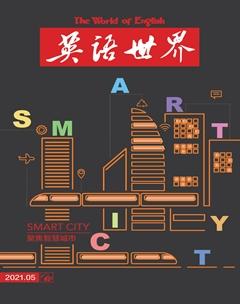How the World Uses Digital Twins to Solidify Smart City Development 数字孪生助力智慧城市建设
袁峰
A s the world becomes increasingly digital and data increases in value and volume, smart cities have grown to become a necessity.
This is primarily because smart cities are the answer to improved infrastructure, fast-tracked1 physical development, augmented operational efficiency and increased standards of living.
Smart solutions and advanced cap-abilities have allowed this to gradually happen but the real deal-maker2 here is the concept of digital twins, which enables a digital replica3 or “twin” of a city to be mapped on a single portal using all the data collected by internet of things (IoT) sensors.
It is an advanced capability that connects the physical world with the virtual world to provide real-time intelligence on urban landscapes and infrastructure via the IoT sensors.
As a result, it is able to create an interconnected information system that reflects the conditions, performance rate, and efficiency of a citys assets and operational systems. Of course, that also means that artificial intelligence (AI) capabilities and advanced analytics are at the core of this technology.
Smart cities around the world can be developed at scale efficiently thanks to this technology but the real highlight is how this technology has been leveraged in various ways to accelerate efforts and solve day-to-day urban-living challenges.
Asias smart city torchbearer: Singapore
This leading adopter of digital twin capabilities has managed to delight its citizens and stakeholders through a maturing Virtual Singapore project where a 3D digital twin of the city has been built to bolster management practices.
Using the technology, the country has managed to empower its research and development, virtual experimentation, decision-making, and test-bedding4 efforts.
For example, emergency situations in congested areas can be simulated to help authorities chart the most effective evacuation plans and safety protocols for the public to practice.
Paving the way to Europes smart city revolution: France
The French have been doing something similar but their goals are more directed towards bolstering architectural developments.
One of its cities, Rennes Metropole5, has also built a 3D model of itself to foolproof6 urban development efforts that take citizens needs and concerns into account.
The 3D models can also help developers, architects, and municipal authorities analyze the limitations or complications that follow construction projects.
Digital twins can also offer insights on how certain decisions could affect a citys landscape and infrastructure in the long run, saving cities from costly failures.
Breaking new ground in the nordic countries: Helsinki
Helsinki of Finland has got a different idea in mind though the 3D concept remains central. The city has leveraged digital twins to fortify its virtual tourism project and become a leading force in that space.
Coined as Virtual Helsinki, the city offers users the experience of “visiting” all its attraction spots at any time of the year using only virtual reality glasses and an app.
The citys digital twin is created in a high-quality 3D model which would allow a realistic touring experience for users and change the dynamics of the countrys tourism offerings.
Redefining urban living for India: Amaravati
Amaravati, the bold new $6.5 billion world-class smart city capital of the Indian state of Andhra Pradesh, is thought to be the first entire city born with a digital twin. The initial 3D prototype of the city was built using Cityzeniths Smart World Pro software7.
Covering 217km?, the project will have a 134km metro network, 316km of main roads, over 100 health centers and schools, 40 colleges, three universities, three key state government buildings, and the capacity to generate nearly 3GW of power. On completion, Amaravati will rank among the top three digitally advanced cities in the world.
Setting a new standard for digitally enabled urban sustainability: Newcastle
In the UK, post-graduate students from Newcastle University, working with Northumbrian Water, have created a digital twin of the city to help it better respond to incidents and disasters. The virtual model allows the water company to run computer-generated simulations of incidents such as burst pipes, heavy rainfall or serious flooding to demonstrate the impact it could have on peoples homes and communities over a 24-hour period in just minutes.
In an interview with the Guardian, Chris Kilsby, professor of hydrology and climate change in Newcastle Universitys School of Engineering, noted how valuable the technology would have been in a situation such as the 2012 “Toon monsoon” when a months rainfall fell in just two hours during rush hour and caused ?8 million worth of damage.
“The digital twin will not only allow the city to react in real time to such freak weather events, but also to test an infinite number of potential future emergencies,” said Kilsby.
“The Toon monsoon overwhelmed the drainage in the city because we just dont design for that sort of event. Theres not someone to blame but the city wasnt resilient.
“In a situation like that, a digital twin of the city would have been very useful. It tells us which buildings will be flooded, which infrastructure will be closed down, hospitals that could be affected. It gives us a picture immediately of which areas will be affected.” ■
隨着世界日益数字化,数据价值提升、体量增大,建设智慧城市已势在必行。
其主要原因是,智慧城市是改善基础设施、加速硬件环境建设、提升运行效率和提高生活水平的锁钥。
智能解决方案和先进技术使智慧城市逐渐普及,但真正的决定性因素是数字孪生这一概念。数字孪生能利用物联网传感器采集的所有数据,将城市的数字化副本(亦即“孪生体”)映射到单一平台上。
这一先进技术将实体世界与虚拟世界相连,通过物联网传感器提供关于城市景观和基础设施的实时信息。
这样就能创建一个互联互通的信息系统,反映城市的资产和运行体系的状态、性能等级和效率。当然,这也意味着人工智能和高级分析是该技术的核心。
有了这项技术,世界各地可以大规模高效发展智慧城市,但真正的亮点在于,人们以各种方式利用该技术来加快行动、化解城市日常生活的各种挑战。
亚洲智慧城市先驱:新加坡
新加坡率先采用数字孪生技术,其日臻成熟的“虚拟新加坡”项目令国民和利益相关方欣喜不已。该项目构建了新加坡的三维数字孪生体,为城市管理提供支持。
这项技术的应用使新加坡得以加强其研发、虚拟实验、决策和试验活动。
例如,可以模拟交通拥塞地区的紧急情况,帮助政府部门制定最有效的分流疏散方案和安全准则,供公众遵行。
为欧洲智慧城市革命铺平道路:法国
法国人一直在做类似的事,但他们的目标更侧重于扶持建筑开发。
法国城市雷恩都会区也已建立该市的3D模型,以确保顾及市民需求和关切的各项城市开发举措万无一失。
3D模型还能帮助开发商、建筑师和市政当局分析建筑项目的后续局限性或新难题。
特定决策会如何长远影响城市的景观和基础设施,对此,数字孪生技术也能使人洞烛机先,使城市避免代价高昂的失误。
在北欧国家中开辟新天地:赫尔辛基
芬兰的赫尔辛基另有主意,尽管3D概念仍为核心。该市利用数字孪生助推虚拟旅游项目,成为这一领域的领军者。
该市为用户提供名为“虚拟赫尔辛基”的体验:只需使用虚拟现实眼镜和一款应用程序,即可全年随时“游览”市内所有景点。
数字孪生体是在高质量的3D模型中创建的,可以为用户提供逼真的游览体验,这将改变芬兰旅游产品的发展态势。
重新定义印度的城市生活:阿马拉瓦蒂
印度安得拉邦新首府阿马拉瓦蒂是一座耗资65亿美元大手笔兴建的世界级智慧城市,被视为首个问世之初即配有全域数字孪生体的城市。该市的初始三维原型是运用Cityzenith公司的Smart World Pro软件构建的。
该项目占地217平方公里,将拥有134公里长的地铁网络、316公里长的主干道路、100多个医疗中心和中小学、40所学院、3所大学、3座重要的邦政府大楼,以及将近3吉瓦的发电容量。项目竣工后,阿马拉瓦蒂将跻身全球三大数字化先进城市之列。
为数字化城市可持续发展设定新标准:纽卡斯尔
在英国,来自纽卡斯尔大学的一群研究生与诺森比亚水务公司合作创建了纽卡斯尔的数字孪生体,以帮助该市更好地应对事故和灾难。水务公司可运用虚拟模型对管道爆裂、暴雨或严重洪涝等事件进行计算机生成模拟,短短几分钟即可演示出此类事件在事发24小时之内可能给民居和社区带来的影响。
在接受英国《卫报》采访时,纽卡斯尔大学工程学院从事水文与气候变化研究的教授克里斯·基尔斯比指出,在2012年“图恩季风”这样的天气状况下,这项技术会发挥极大作用。当时,在交通高峰时间,通常一个月的降雨量在短短两小时内倾泻而下,造成价值800万英镑的损失。
基尔斯比说:“数字孪生体不仅可以让城市对此类异常气象事件做出实时反应,还可让城市测试未来可能发生的不计其数的紧急情况。”
“图恩季风使城市排水系统不堪重负,因为我们的设计根本就没考虑防范此类事件。没法怪罪任何人,在当时,这座城市不具抗灾韧性。
“在当时那种情况下,城市的数字孪生体会非常有用。它告诉我们哪些建筑将遭水淹,哪些基础设施会被关闭,哪些医院或受影响,让我们即时了解哪些区域会受灾。” □
(译者为“《英语世界》杯”翻译大赛获奖者)
1 fast-track加速……的进程。 2 deal-maker本义为“促成交易的关键人物”,此处喻指“成功的决定性因素”。 3 replica复制品。
4 test-bed试验,测试。
5由法国西北部城市雷恩及其周边42个市镇所组成的一个市镇公共合作组织,是法国22个“都会区”之一。其前身为1960年成立的“雷恩地区”(Rennes District)。 6 foolproof确保安全。
7 Cityzenith是美国顶尖智慧城市软件公司,其联合创始人之一曾参与创建了“谷歌地球”。Smart World Pro是一个数字孪生软件平台,可访问超过10亿个经过地理标记的地理标记数据层。
- 英语世界的其它文章
- What Does a Smart City Look Like? 智慧城市什么样?
- Smart City Vs. Normal City: What Are the Differences? 智慧城市与普通城市有何差别?
- A Smart City: More Than Just Tech 智慧城市不止科技
- Smart City: The Top Stories of 2020 2020年智慧城市杰出案例
- Covid-19 Unlocks the Potential of Smart Cities in China 新冠解锁中国智慧城市潜力
- The Shenzhen Effect 深圳效应

